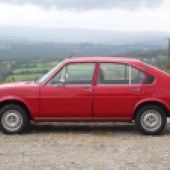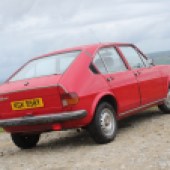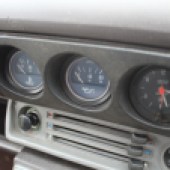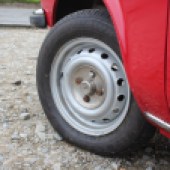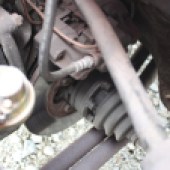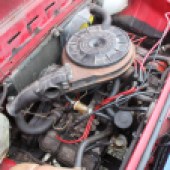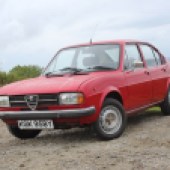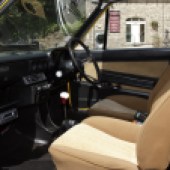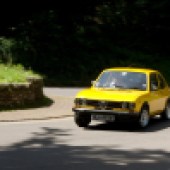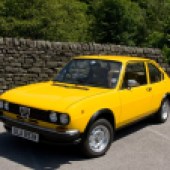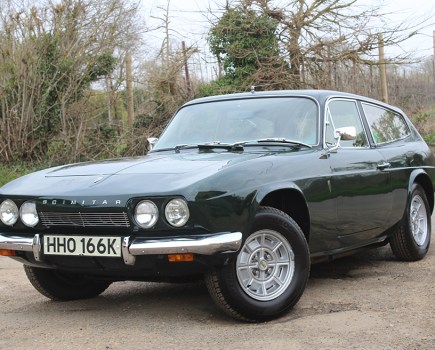Alfa’s innovative family car set new standards – high ones for handling, and low ones for corrosion resistance. But there’s really never been a better time to buy an Alfa Romeo Alfasud
Words: Jack Grover
The Alfasud had many goals, and all of them lofty. It was to bring Alfa Romeo into the mass family car market. It would bring employment to a deprived part of Italy and address the country’s stark north/south divide. It was to set new benchmarks in dynamics, refinement and engineering for that class.
Unfortunately the ‘Sud achieved only the last of those goals. From the moment it was launched it was the yardstick for how well any family car (let alone a front-wheel drive one with spacious seating for five and class-leading refinement) could drive. It would remain one for many years after its demise. It was famed for its flat, poised and on-rails cornering characteristics. To which the ‘Sud added a charismatic flat-four engine, a slick gearchange and perfectly weighted steering full of feedback.
The Alfa Romeo Alfasud was a brilliant package – but one that was let down by execution. The factory near Naples was riddled with technical and labour difficulties. Stoppages, indifferent quality control, low morale and poor materials were endemic. This lead to the Alfasud gaining a reputation for rampant rust issues. It could infect cars even during their warranty period and many needed work to pass their first MoT. Fragile trim, finnicky electrics and leaky windscreens added to the woes.
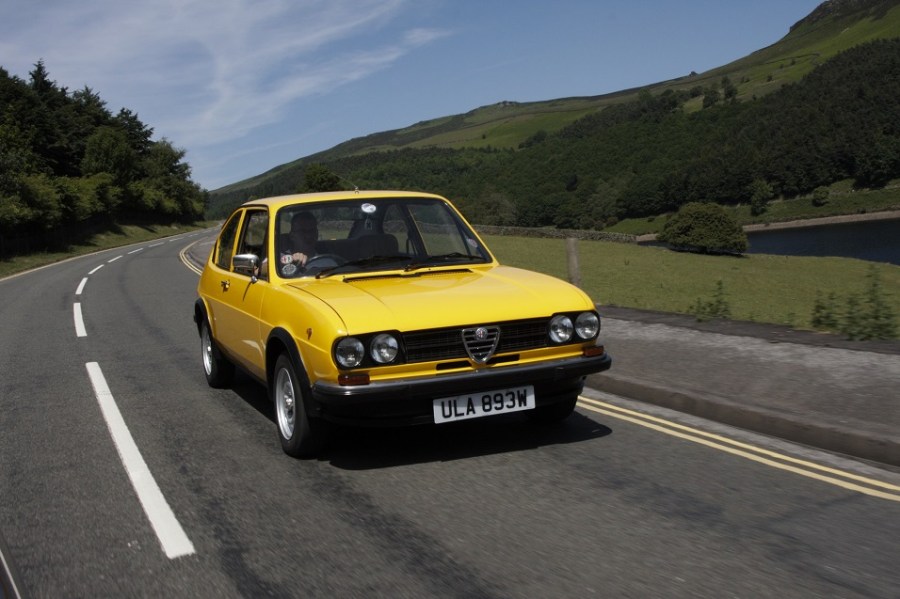
Conceived as an accessible high-volume family car, Alfasud production barely made it to a third of the predicted level. This made the entire project a financial failure that tipped Alfa Romeo into bankruptcy. The ‘Sud had to be re-pitched as an upmarket small sports saloon that could command a higher price. But the ‘Sud’s humble origins meant that it was only in the very last years of its life that it gained enough pace to be a true performance car. Until the 1980s it was only built as a saloon, limiting its practicality in a market segment increasingly favouring the hatchback. More practical, more powerful, more robust products like the Volkswagen Golf GTI soon dominated the market. A market that the Alfasud should have mastered.
Unsurprisingly the survival rate of the Alfasud is miniscule – many didn’t make it past a decade of life on Britain’s salty roads. There are only around 100 or so ‘Suds out there now. But the appeal as a driver’s car, a classic and a piece of automotive history is strong. Nearly all those 100-odd cars will have been restored or preserved. In many ways it’s never been easier to buy an Alfasud. But you have to be careful.
Bodywork
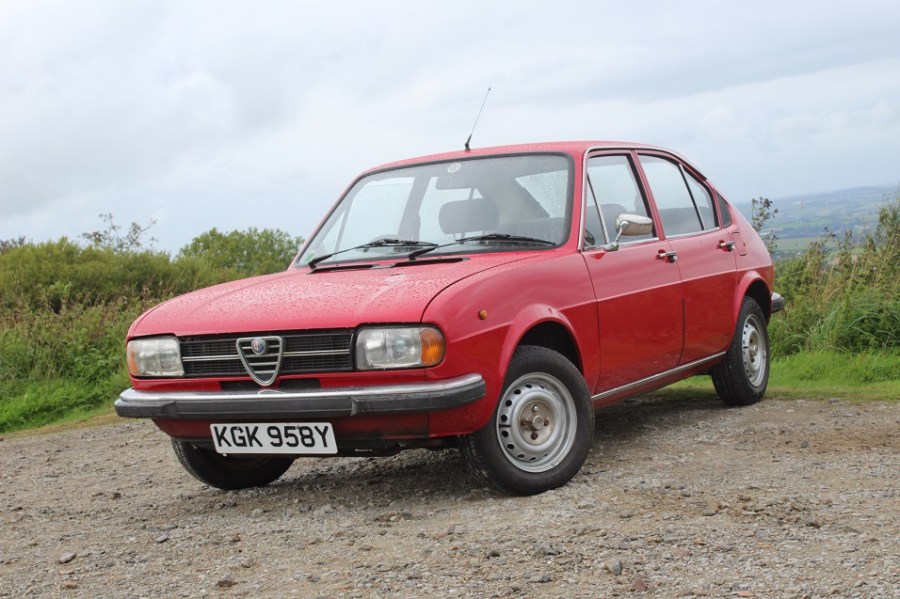
The word Alfasud is still synonymous with the word rust to many. Stoppages at the factory that led to unpainted shells sitting outside in humid Neapolitan air. Recycled steel full of impurities and indifferent paint application also played a part. A ‘Sud could start blooming with rust almost anywhere, and from the middle of virtually any panel.
These days the Alfa Romeo Alfasud buyer can rest slightly easier in that the survivors are nearly all the ones that have been restored, been pampered, protected from new or imported from drier climates. But corrosion is still the killer of Alfasuds and with panels of limited availability and significant expense, it simply isn’t feasible to repair a rotten ‘Sud – and in any case the joy of an Alfa Romeo Alfasud is in driving it, not welding it.
While a careful eye should be run over the entire car, the rot issues do tend to be found in a few key places – mostly in the lower half of the body. Check all the external panels – wings, doors, boot lid, bonnet, roof and valances – for bubbles of paint or specks of rust which indicate worse lying within. Then check the surrounds of both the windscreen and (on earlier saloon models) the rear window, as well as the C-pillars and (on two/three-door cars) the rear quarter windows. The windscreen surround is especially key as rot here will seriously affect the structural integrity of the car and be fearsomely expensive to repair. Extend your search down the bulkhead and around the front door hinges. Then inspect the lower part at the front of the sills, the rear of the front wings (inner and outer) and the front floors.
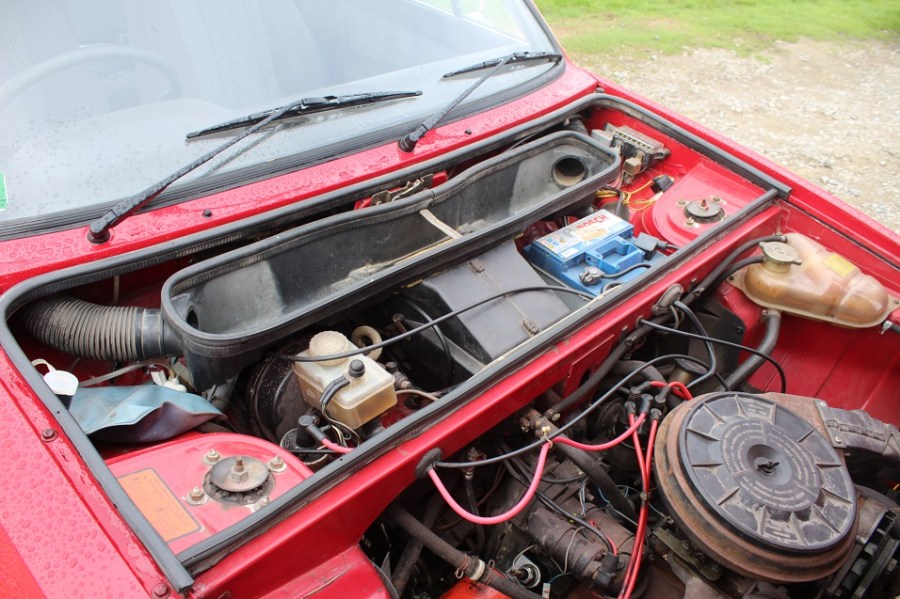
In the engine bay, check the ‘chassis’ legs that support the drivetrain, the inside of the inner wings (especially around the front suspension strut mounts) and the metal around the steering rack mounts. Then shift your inspection to the ‘bathtub’ pressing that holds the heater box, battery and brake cylinders (leaks from the last two can cause rust to set in) and is formed by the integral brace between the strut tops. Move back, looking at the length of the sills and all the floors. Be sure that the structure around the mounts for the rear springs and location links is solid, then do the same for the boot floor and spare wheel well.
If that seems like a list of all the structural parts of an Alfasud – you’re right! They can rust almost anywhere and, thanks to the minimalist design and clever use of as little metal as possible there is little ‘spare’ and virtually every part serves some vital purpose.
Engine and transmission
Once an Alfasud is deemed structurally sound, it’s largely plain sailing as they are mechanically robust with few particular issues. The engine is worked hard, especially in smaller-capacity form, and these days the most common issue is going to be worn rings and bores, tired valve guides, perished stem seals and the like. All will cause burning oil and blue exhaust smoke – under load if it’s the bores, when starting or idling if it’s valve-related. Parts for the Alfa flat-four are readily available and it is a simple engine to work on, so do not be deterred from an otherwise sound car by a tired engine.
Do beware more serious (and expensive) problems in the bottom end. If a gauge is fitted, look for at least 20psi of oil pressure at a hot idle (or the same in the brilliantly Italian unit of ‘hectograms per square centimetre’ if looking at a car with metric instruments) and at least 55psi or 40hg/cm2 when on the move. Check that the oil and coolant are both clean and that there are no oil leaks from the crank seals or cam covers. Alfa Romeo Alfasud engines are usually pretty oil-tight, so leaks imply that it’s being forced out by heavy ‘breathing’ from worn bores.

Alfasuds feature a coolant temperature warning light, as well as a gauge on higher-spec models. The light illuminates when the engine is cold both as a test function and a reminder not to drive the car as it demands until it has warmed up. Similarly, the brake fluid level warning light does double duty for the choke. Be sure that the temperature doesn’t rise when the engine is worked hard or after long periods at idle. If the engine does have trouble keeping its cool, it’s likely that the coolant passages are clogged from insufficient maintenance or the radiator finning has corroded away. Radiators, thermostats, hoses and so on are available new but problems like this may be indicative of overall upkeep.
Despite its raspy exhaust note the boxer engine should run smoothly at all speeds and throttle positions. All develop their best power and torque at relatively high revs, so they do have to be worked hard. Only the very largest and latest could really be described as powerful. But they should always feel willing and should pull cleanly. If they don’t it’s likely to be a worn or out-of-tune carburettor. On twin-carb models they really need to be in balance to drive as they should. Any classic specialist or engine tuner familiar with Weber carburettors should be able to bring it back up to scratch at modest expense. Worn ignition components, especially degraded HT leads, can cause intermittent stuttering or periods of running on three cylinders. The two cambelts need to be replaced every 36,000 miles.

The gearbox is tough and tends to only suffer from indifferent synchromesh at high mileages, especially on second gear. It is inherently prone to rattle when idling in neutral; so long as noises disappear with the clutch down and there is no prominent noise when on the move then assume all is well. Be sure that the clutch is in good condition – no signs of slip, no judder from warped plates, no thrashing sounds from the release bearing, smooth action – as replacement requires dropping both engine and gearbox.
The gearchange was always one of the Alfasud’s most praised features, and should be crisp, positive and smooth. If it isn’t then the bushes are probably worn. Some of these are easy to replace since they are the same as on the later Alfa 33, but some ‘Sud-specific ones are not available.
Drive in a tight circle on full lock and listen for click-clack sounds telling of worn universal joints in the front driveshafts.A few on/off/on/off bursts of throttle at low speeds will test for any slop in the splines as well as the soundness of the drivetrain mounts.
Suspension, steering and brakes
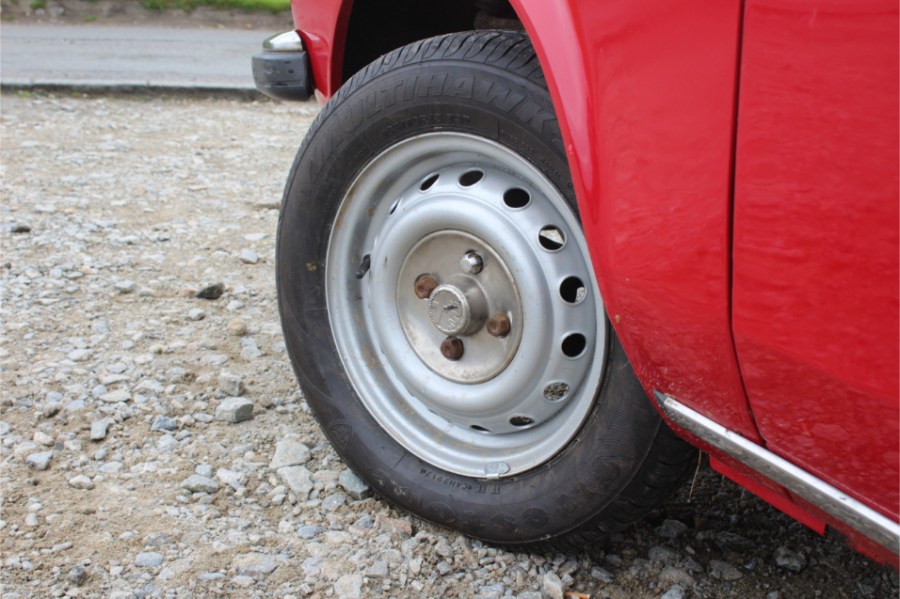
Like a lot of the Alfa Romeo Alfasud’s engineering, the running gear is simple but effective. Macpherson struts at the front and a dead beam axle at the back restrained by Watt’s linkages and a Panhard rod make for a long-lived setup. But this does mean there is a higher than normal number of bushes in the system. A notable characteristic of the ‘Sud is its relatively soft suspension bushings, which even in-period led to some overzealous MoT testers failing Alfasuds on their first examinations.
This ‘squishiness’ gives the ‘Sud an amount of dialled-in rear-axle steering and lets it settle into fast corners. So don’t be alarmed by quite a bit of relative movement in the front wishbones or the rear Watt’s linkages. But be aware of the difference between soft bushes and worn ones and check for perished or split rubbers. The rear Panhard rod and the steering joints should have little to no free play. Check the wishbones themselves for rust.
The steering should be light, accurate and smooth. If it’s stiff then the roller bearings at the top of the struts needs replacing – they cost about £30 each.
Four-wheel disc brakes were another of the Alfa Romeo Alfasud’s vaunted features. Ironically, they’re so effective that problems surface because they don’t work hard enough. The ‘Sud is a light car and what weight there is is in the front. This means that the rear brakes do very little work and even on cars in daily use corrosion of the discs and seizure of the caliper pistons can be a recurring problem.
As well as a visual check, listen for rubbing or grinding noises from the rear and feel for uneven or erratic braking, especially if a sharp application is made. Conversely, the front brakes tend to suffer from accelerated pad wear, made worse by the perceived difficulty in changing and adjusting the pads due to the inboard location. This also makes the brakes prone to oil contamination from engine, gearbox or driveshaft oil leaks. Check the discs for wear, scoring and signs of oil.

Interior, trim and electrics
Most Alfa Romeo Alfasuds have cloth or part-cloth trim (leather seats were only found on top-spec late cars). None of the interior trim or furnishings is particularly hard wearing. You’ll often find ‘Suds with worn, frayed or split seats, especially on the driver’s side. The vinyl parts of seats are similarly brittle, and dashboard and door plastics often warp or crack. A car from a sunny part of Europe may have escaped the worst of the rust problem, but the interior will usually have suffered instead. A car with a straight, tidy interior is worth a premium. Instruments and switches aren’t too hard to find and much of it is shared with other contemporary Alfa products, but Sud-specific parts (especially for pre-facelift right-hand drive cars) can be expensive to source. But most parts can be found, especially if you’re willing to navigate Italian online retailers.
Switchgear was never going to give Mercedes sleepless nights, and after 40-plus years controls may break or feel very sloppy. This goes especially for the rather fragile steering column stalks. As well as the expected things, one stalk operates the heater fan on the ‘Sud – it’s not a bizarre earth fault. Not that earth faults are unknown (far from it) but they’re usually down to corroded body fittings or connectors. Check everything works as it should, and there’s no ‘leakage’ from one circuit to another.
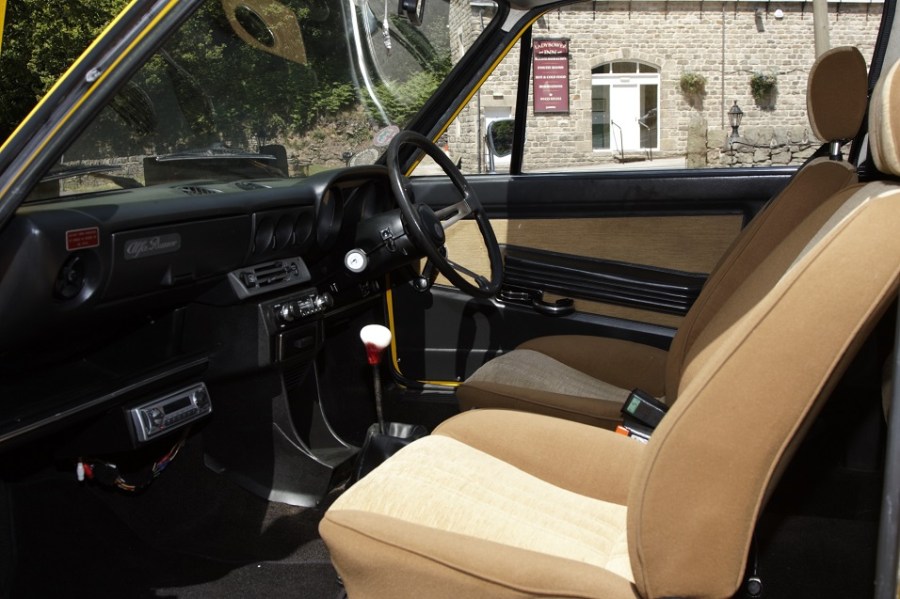
Alfa Romeo Alfasud: our verdict
The Alfa Romeo Alfasud is thoroughly deserving of classic status. In a world of overweight, overpowered, desensitised hyper-hatches the ‘Sud provides a valuable lesson in raw, tactile driving. It has as much to offer the keen driver as any sports car and the technically minded will find much to love in its quirky but thoroughly logical engineering. As values for 1980s hot hatches boom, the ‘Sud remains a better driving experience than all of them. If you can find one of the rare survivors, the rust that so blighted the breed in its day is not as much of a menace as it was. You’ll also find an Alfasud turns heads and starts conversation wherever it goes. You do have to buy with care to prevent taking on lots of problems that outweigh the value and the charm of the car.
That’s especially the case because despite their rarity and the increasing esteem in which they’re held, Alfasud’s are not all that valuable. There is also a big divergence in values between the ‘hot’ models (the ti and the Cloverleaf) and the standard four/five-door ones. A late QV in pristine condition can go for £15,000-20,000, while a 1.5ti or 1.3ti would be £12,000-17,500. It would take an exceptionally good five-door 1.5 to make much over £10,000 and an average one will be £6000-7500. A restored pre-facelift 1.3 Super is worth around £8000 and a solid one about £4000-5000. With the non-sporting ‘Sud’s especially, the sheer rarity makes price trends hard to pin down and, at auctions especially, prices paid depend very much on who is buying at any given time.
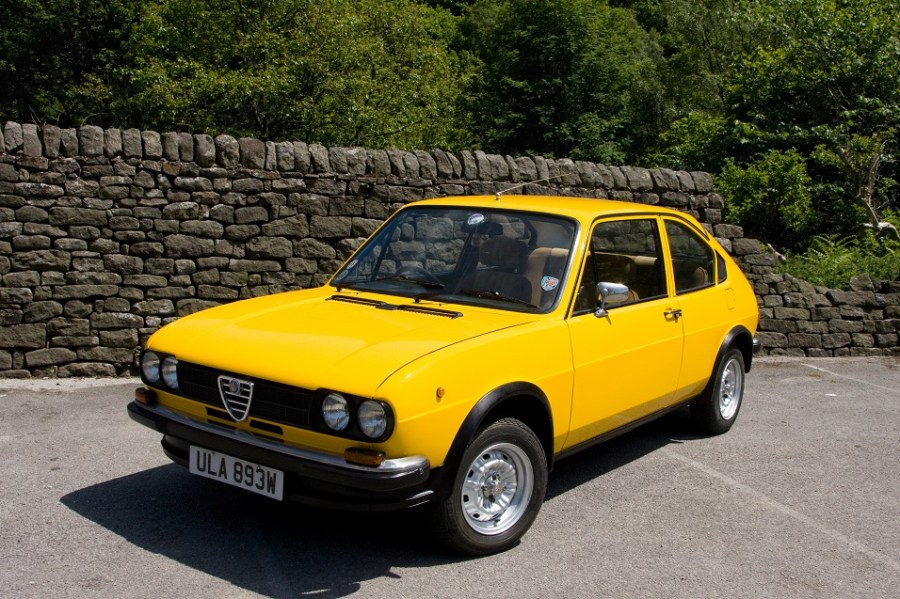
Alfa Romeo Alfasud timeline
1972
Alfa Romeo Alfasud production starts in April, with a 1186cc single-carb 63bhp engine in a four-door saloon body.
1973
Production of right-hand drive Alfasuds begins.
1974
The two-door ti is introduced, with boot and chin spoilers and quadruple round headlamps. Extra instruments in dashboard and sculpted seats with head restraints fitted. Five-speed gearbox. Engine has twin-choke carburettor with 68bhp. Higher-spec SE version of standard four-door model launched.
1975
Alfasud L (‘Lusso’) replaces the SE, with same interior spec as the ti. Three-door estate model (the Giardinetta) launched, but never sold in the UK.
1976
Alfasud L replaced by the 5M, bringing the five-speed gearbox to the four-door ‘Sud. The basic (‘Normale’) model retains the four-speed ‘box.
1977
In July the ti 1.3 is introduced with a 1286cc engine of 75bhp. Later in the year the 5M is superseded by the Alfasud Super. This is available with single-choke 1.2- or 1.3-litre engines. The Super features plastic-clad bumpers, new door trims and seats in either vinyl or cloth.
1978
The ti receives the choice of 78bhp 1350cc or 85bhp 1490cc engines with twin-choke carburettors. The same exterior and interior revisions as the Super are made, plus wheel arch eyebrows. These engines were then introduced in single-choke carb form on the Super.
1980
Heavy facelift introduces new plastic bumpers, a redesigned fascia and dashboard, different grille, headlamps and taillamps. The ti now uses a twin-carburettor 1.5-litre engine of 95bhp.
1981
A three-door hatchback body is introduced, replacing all existing two-door models in the UK.
1982
The four-door saloon is replaced by a five-door hatchback. What was the Super is now badged as the SC. The Gold Cloverleaf model has the engine from the Ti with more luxury-orientated trim.
1983
The ultimate version of the ti, the Green Cloverleaf (‘Quadrifoglio Verde’ or QV) is introduced. Offers the three-door body, a 105bhp 1.5-litre engine and low-profile metric tyres plus extra interior equipment.
1984
Alfasud production ends after nearly 894,000 were built.


